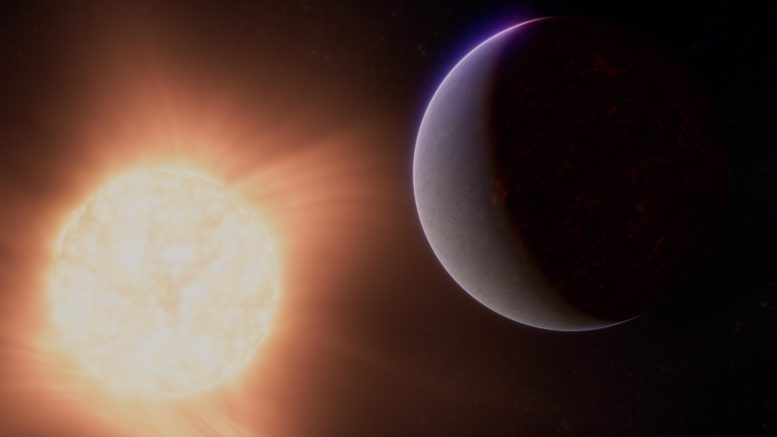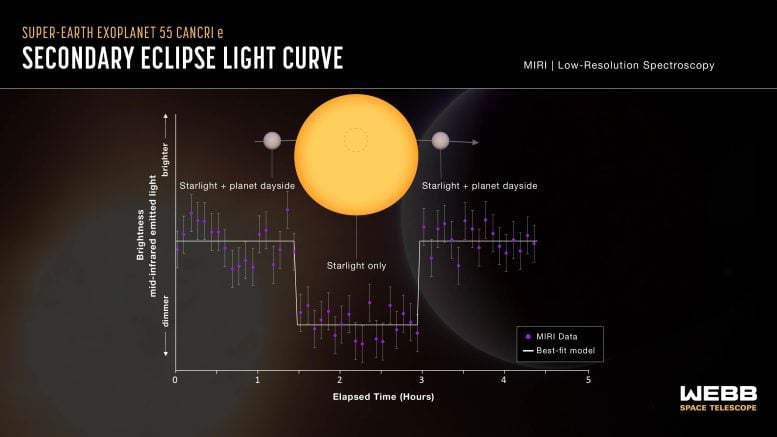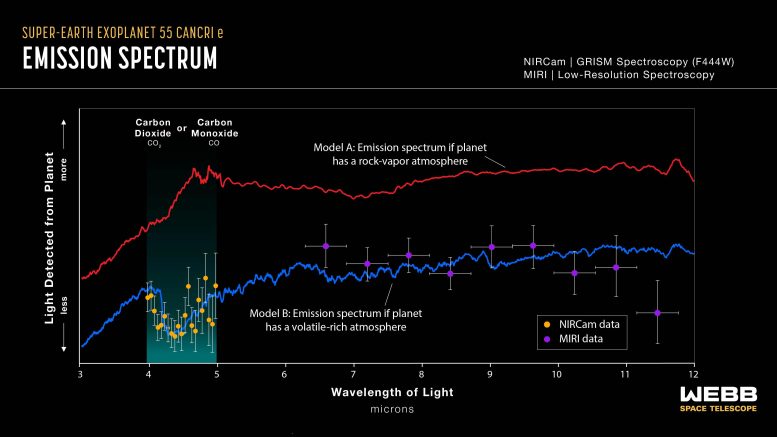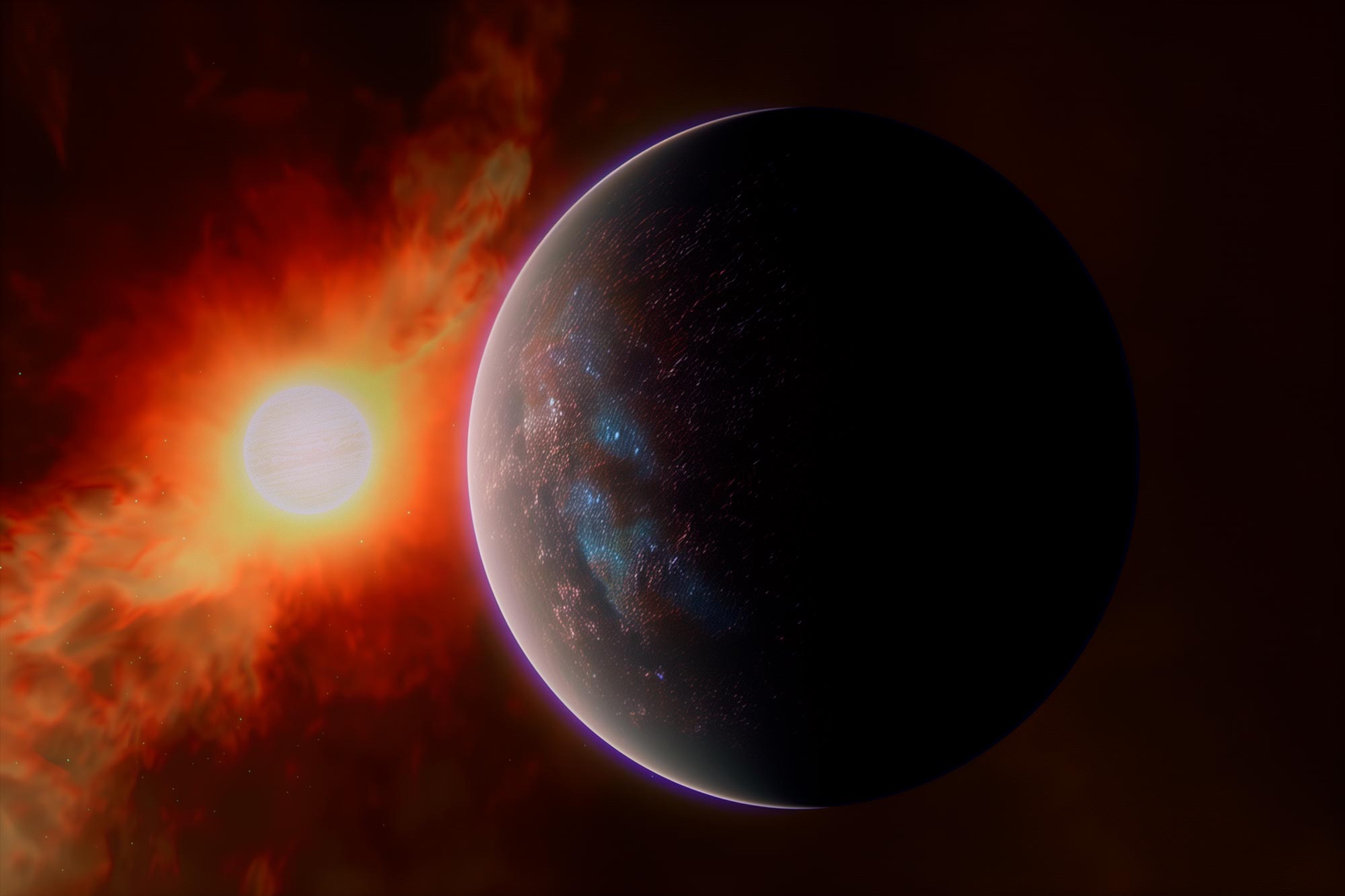Using NASA’s James Webb Space Telescope, scientists may have identified atmospheric gases on 55 Cancri e, a super-hot, rocky exoplanet. This discovery could represent the most definitive evidence of an atmosphere on any rocky planet outside our solar system. Credit: SciTechDaily.com
Gas bubbling up from a lava-covered surface on 55 Cancri e may feed an atmosphere rich in carbon dioxide or carbon monoxide.
These days, detecting a planetary atmosphere tens or even hundreds of light-years from Earth might not sound like such a big deal. Scientists have found signs of atmosphere surrounding dozens of exoplanets over the past two decades. The catch is, all those planets have thick, hydrogen-dominated atmospheres that are relatively easy to study. The much thinner blankets of gas that almost certainly surround some small, rocky exoplanets have remained elusive.
Researchers think they may have finally caught a glimpse of a volatile-rich atmosphere surrounding a rocky planet. Light emitted by the hot, highly-irradiated exoplanet 55 Cancri e shows compelling evidence for an atmosphere, probably rich in carbon dioxide or carbon monoxide, which may be bubbling from a vast ocean of lava covering the planet’s surface.
The result is the best evidence to date for a rocky planet atmosphere outside our solar system.

This artist’s concept shows what the exoplanet 55 Cancri e could look like. Also called Janssen, 55 Cancri e is a so-called super-Earth, a rocky planet significantly larger than Earth but smaller than Neptune, which orbits its star at a distance of only 1.4 million miles (0.015 astronomical units), completing one full orbit in less than 18 hours. (Mercury is 25 times farther from the Sun than 55 Cancri e is from its star.) The system, which also includes four large gas-giant planets, is located about 41 light-years from Earth, in the constellation Cancer. Credit: NASA, ESA, CSA, Ralf Crawford (STScI)
Webb Space Telescope Hints at Possible Atmosphere Surrounding Rocky Exoplanet
Researchers using NASA’s James Webb Space Telescope may have detected atmospheric gases surrounding 55 Cancri e, a hot rocky exoplanet 41 light-years from Earth. This is the best evidence to date for the existence of any rocky planet atmosphere outside our solar system.
Renyu Hu from NASA’s Jet Propulsion Laboratory (JPL) in Pasadena, California, is lead author on a paper published on May 8 in Nature. “Webb is pushing the frontiers of exoplanet characterization to rocky planets,” Hu said. “It is truly enabling a new type of science.”
Super-Hot Super-Earth 55 Cancri e
55 Cancri e, also known as Janssen, is one of five known planets orbiting the Sun-like star 55 Cancri, in the constellation Cancer. With a diameter nearly twice that of Earth and density slightly greater, the planet is classified as a super-Earth: larger than Earth, smaller than Neptune, and likely similar in composition to the rocky planets in our solar system.
To describe 55 Cancri e as “rocky,” however, could leave the wrong impression. The planet orbits so close to its star (about 1.4 million miles, or one-twenty-fifth the distance between Mercury and the Sun) that its surface is likely to be molten – a bubbling ocean of magma. With such a tight orbit, the planet is also likely to be tidally locked, with a dayside that faces the star at all times and a nightside in perpetual darkness.
In spite of numerous observations since it was discovered to transit in 2011, the question of whether or not 55 Cancri e has an atmosphere – or even could have one given its high temperature and the continuous onslaught of stellar radiation and wind from its star – has gone unanswered.
“I’ve worked on this planet for more than a decade,” said Diana Dragomir, an exoplanet researcher at the University of New Mexico and co-author on the study. “It’s been really frustrating that none of the observations we’ve been getting have robustly solved these mysteries. I am thrilled that we’re finally getting some answers!”
Unlike the atmospheres of gas giant planets, which are relatively easy to spot (the first was detected by NASA’s Hubble Space Telescope more than two decades ago), thinner and denser atmospheres surrounding rocky planets have remained elusive.
Previous studies of 55 Cancri e using data from NASA’s now-retired Spitzer Space Telescope suggested the presence of a substantial atmosphere rich in volatiles (molecules that occur in gas form on Earth) like oxygen, nitrogen, and carbon dioxide. But researchers could not rule out another possibility: that the planet is bare, save for a tenuous shroud of vaporized rock, rich in elements like silicon, iron, aluminum, and calcium. “The planet is so hot that some of the molten rock should evaporate,” explained Hu.

This light curve shows the change in brightness of the 55 Cancri system as the rocky planet 55 Cancri e, the closest of the five known planets in the system, moves behind the star. This phenomenon is known a secondary eclipse.
When the planet is next to the star, the mid-infrared light emitted by both the star and the dayside of the planet reaches the telescope, and the system appears brighter. When the planet is behind the star, the light emitted by the planet is blocked and only the starlight reaches the telescope, causing the apparent brightness to decrease.
Astronomers can subtract the brightness of the star from the combined brightness of the star and planet to calculate how much infrared light is coming from the dayside of the planet. This is then used to calculate the dayside temperature and infer whether or not the planet has an atmosphere.
Credit: NASA, ESA, CSA, Joseph Olmsted (STScI), Aaron Bello-Arufe (NASA-JPL)
Measuring Subtle Variations in Infrared Colors
To distinguish between the two possibilities, the team used Webb’s NIRCam (Near-Infrared Camera) and MIRI (Mid-Infrared Instrument) to measure 4- to 12-micron infrared light coming from the planet.
Although Webb cannot capture a direct image of 55 Cancri e, it can measure subtle changes in light from the system as the planet orbits the star.
By subtracting the brightness during the secondary eclipse (see image above), when the planet is behind the star (starlight only), from the brightness when the planet is right beside the star (light from the star and planet combined), the team was able to calculate the amount of various wavelengths of infrared light coming from the dayside of the planet.
This method, known as secondary eclipse spectroscopy, is similar to that used by other research teams to search for atmospheres on other rocky exoplanets, like TRAPPIST-1 b.

A thermal emission spectrum captured by Webb’s NIRCam (Near-Infrared Camera) in November 2022, and MIRI (Mid-Infrared Instrument) in March 2023, shows the brightness (y-axis) of different wavelengths of infrared light (x-axis) emitted by the super-Earth exoplanet 55 Cancri e. The spectrum shows that the planet may be surrounded by an atmosphere rich in carbon dioxide or carbon monoxide and other volatiles, not just vaporized rock.
The graph compares data collected by NIRCam (orange dots) and MIRI (purple dots) to two different models. Model A, in red, shows what the emission spectrum of 55 Cancri e should look like if it has an atmosphere made of vaporized rock. Model B, in blue, shows what the emission spectrum should look like if the planet has a volatile-rich atmosphere outgassed from a magma ocean that has a similar volatile content as Earth’s mantle. Both MIRI and NIRCam data are consistent with the volatile-rich model.
The amount of mid-infrared light emitted by the planet (MIRI) shows that its dayside temperature is significantly lower than what it would be if it did not have an atmosphere to distribute heat from the dayside to the nightside. The dip in the spectrum between 4 and 5 microns (NIRCam data) can be explained by absorption of those wavelengths by carbon monoxide or carbon dioxide molecules in the atmosphere.
Credit: NASA, ESA, CSA, Joseph Olmsted (STScI), Renyu Hu (NASA-JPL), Aaron Bello-Arufe (NASA-JPL), Michael Zhang (University of Chicago), Mantas Zilinskas (SRON)
Cooler Than Expected
The first indication that 55 Cancri e could have a substantial atmosphere came from temperature measurements based on its thermal emission (see image above), or heat energy given off in the form of infrared light. If the planet is covered in dark molten rock with a thin veil of vaporized rock or no atmosphere at all, the dayside should be around 4,000 degrees Fahrenheit (~2,200 degrees Celsius).
“Instead, the MIRI data showed a relatively low temperature of about 2,800 degrees Fahrenheit [~1540 degrees Celsius],” said Hu. “This is a very strong indication that energy is being distributed from the dayside to the nightside, most likely by a volatile-rich atmosphere.” While currents of lava can carry some heat around to the nightside, they cannot move it efficiently enough to explain the cooling effect.
When the team looked at the NIRCam data, they saw patterns consistent with a volatile-rich atmosphere.”
We see evidence of a dip in the spectrum between 4 and 5 microns — less of this light is reaching the telescope,” explained co-author Aaron Bello-Arufe, also from NASA JPL. “This suggests the presence of an atmosphere containing carbon monoxide or carbon dioxide, which absorb these wavelengths of light.” A planet with no atmosphere or an atmosphere consisting only of vaporized rock would not have this specific spectral feature.
“We’ve spent the last ten years modeling different scenarios, trying to imagine what this world might look like,” said co-author Yamila Miguel from the Leiden Observatory and the Netherlands Institute for Space Research (SRON). “Finally getting some confirmation of our work is priceless!”
Bubbling Magma Ocean
The team thinks that the gases blanketing 55 Cancri e would be bubbling out from the interior, rather than being present ever since the planet formed. “The primary atmosphere would be long gone because of the high temperature and intense radiation from the star,” said Bello-Arufe. “This would be a secondary atmosphere that is continuously replenished by the magma ocean. Magma is not just crystals and liquid rock; there’s a lot of dissolved gas in it, too.”
While 55 Cancri e is far too hot to be habitable, researchers think it could provide a unique window for studying interactions between atmospheres, surfaces, and interiors of rocky planets, and perhaps provide insights into the early conditions of Earth, Venus, and Mars, which are thought to have been covered in magma oceans far in the past. “Ultimately, we want to understand what conditions make it possible for a rocky planet to sustain a gas-rich atmosphere: a key ingredient for a habitable planet,” said Hu.
This research was conducted as part of Webb’s General Observers (GO) Program 1952. Analysis of additional secondary eclipse observations of 55 Cancri e are currently in progress.
Reference: “A secondary atmosphere on the rocky Exoplanet 55 Cancri e” by Renyu Hu, Aaron Bello-Arufe, Michael Zhang, Kimberly Paragas, Mantas Zilinskas, Christiaan van Buchem, Michael Bess, Jayshil Patel, Yuichi Ito, Mario Damiano, Markus Scheucher, Apurva V. Oza, Heather A. Knutson, Yamila Miguel, Diana Dragomir, Alexis Brandeker and Brice-Olivier Demory, 8 May 2024, Nature.
DOI: 10.1038/s41586-024-07432-x
The James Webb Space Telescope is the world’s premier space science observatory. Webb is solving mysteries in our solar system, looking beyond to distant worlds around other stars, and probing the mysterious structures and origins of our universe and our place in it. Webb is an international program led by NASA with its partners, ESA (European Space Agency) and the Canadian Space Agency.

Dr. Sarah Adams is a scientist and science communicator who makes complex topics accessible to all. Her articles explore breakthroughs in various scientific disciplines, from space exploration to cutting-edge research.



:max_bytes(150000):strip_icc()/VWH-GettyImages-1316976951-d124a033125c4ccb8b3fde998d4ef4c5.jpg)


